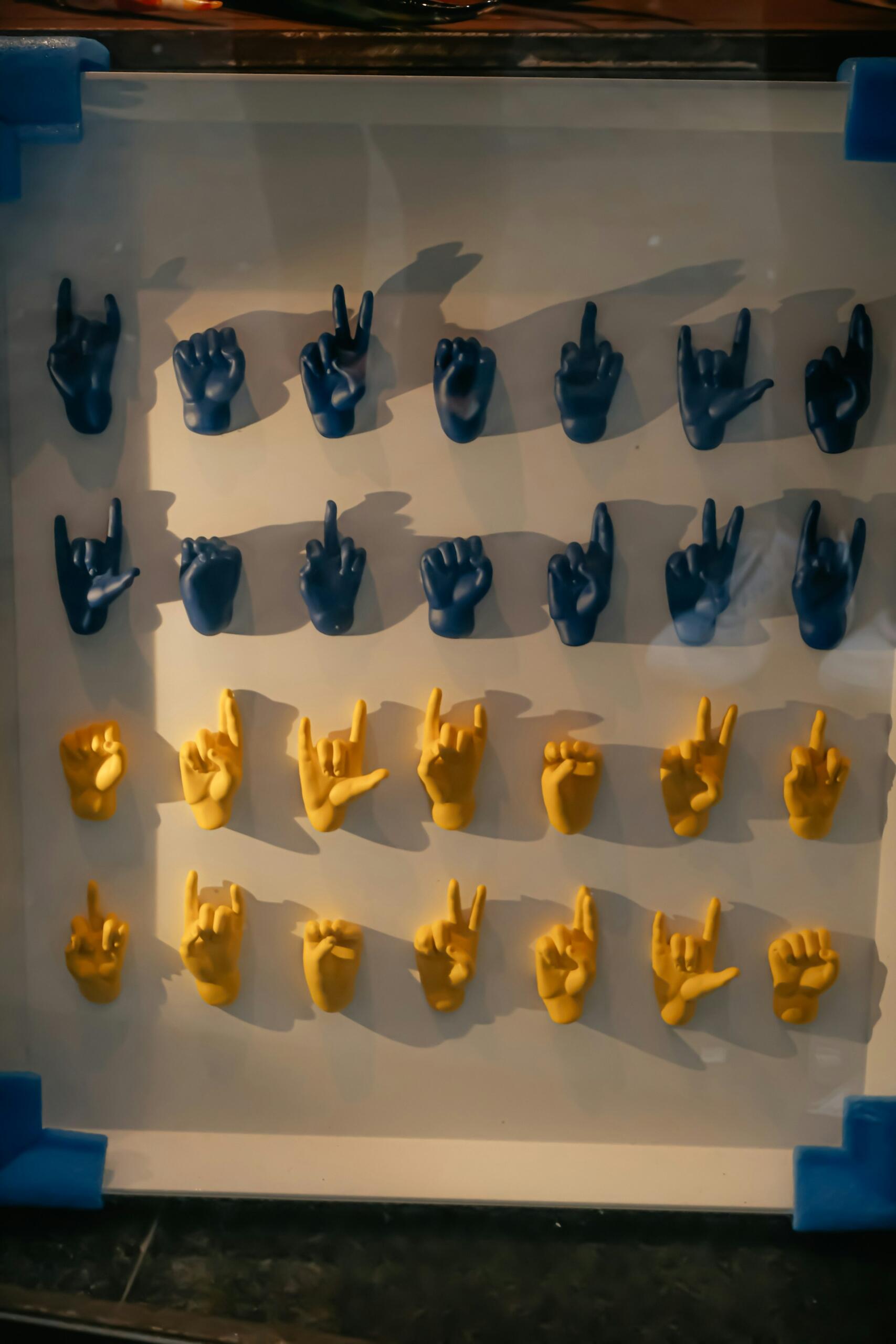Sign language is used as a means of communication by and for people who are deaf or have a hearing impairment. This means of communication is a valuable tool that can be used in various situations. The language is comprised of several key elements, including handshape, palm orientation, movement, location, and expression/non-manual signals. Let's explore the features of sign language and its importance in communication for the deaf community.
Start taking American Sign Language classes here on Superprof.

What Are the Key Characteristics of Sign Language?
Sign language uses visual and gestural communication to convey a message. It is used by people with hearing impairments as well as by hearing individuals who work with or interact with the deaf community. Let's discuss the 5 components of sign language!
Hand Shape
First up on the list of sign language characteristics is hand shape, which refers to the specific configuration of the hand and fingers used to make a sign. Sign language uses a variety of hand shapes to differentiate between words and concepts. For instance, the sign for the word "house" uses the hand shape of a roof, while the sign for "car" uses the hand shape of a steering wheel.
Movement
Movement refers to the motion of the hands and arms when making a sign. Some signs involve a single movement, while others involve multiple movements. For instance, the sign for "fast" involves a quick movement of the hand, while the sign for "slow" involves a slower movement.

Location
Location refers to the position of the hands and arms when making a sign. Different signs are made at different locations on or near the body. For instance, the sign for "eye" is made near the face, while the sign for "foot" is made near the foot.
Palm Orientation
Palm orientation refers to the direction that the palm of the hand is facing while making a sign. This gesture conveys important information about the meaning of the sign. For instance, the sign for "you" uses a palm-up orientation, while the sign for "me" uses a palm-down orientation.
Facial Expression/Non-Manual Signals
Facial expression plays an important role in sign language. Facial expressions can convey emotions, attitudes, and other nonverbal cues that help to clarify the meaning of a sign. For instance, a raised eyebrow can indicate a question, while a furrowed brow can indicate confusion.
The key components of sign language are handshape, palm orientation, movement, location, and expression/non-manual signals.
What Are the Basics of Sign Language?
Sign language is used primarily by people who are deaf or hard of hearing, but it can also be used by anyone who wants to communicate with them. Sign language is not universal, and there are many sign languages used around the world, each with its own grammar and vocabulary. It is a visual language that uses gestures, facial expressions, and body language to convey messages. It can be used to connect with people with special needs and from different cultures and backgrounds.
Let's cover the basics of sign language!
Alphabet
The best way to learn sign language is learning the alphabet. It is one of the first things that people learn in sign language courses. The sign language alphabet uses hand gestures to represent each letter of the alphabet. This is a useful tool for spelling out words or names that do not have a sign.
Numbers
Just like the alphabet, sign language has a set of hand gestures that represent numbers. This allows sign language users to communicate numbers, such as phone numbers and addresses without having to write them down.

Vocabulary
Sign language has its own vocabulary, with signs for common words, phrases, and concepts. For example, the sign for "hello" is a simple wave of the hand, while the sign for "goodbye" is a similar wave but with a different hand gesture.
Grammar
Sign language has its own grammar and syntax. The order in which signs are used can change the meaning of a sentence, just like in spoken languages. For example, in English, we say, "I am going to the store," but in sign language, the sign for "store" would come before the sign for "going."

What Are the Benefits of Learning Sign Language?
Sign language isn't just limited to those with hearing impairments. Learning sign language has many benefits for people with perfect hearing as well. From communication to career opportunities, read on to learn more about the benefits of learning sign language.
Communication
Learning someone else's language is what makes communication possible. Sign language is a great way to communicate with people with hearing impairments. It helps to bridge the communication gap between people who can hear and those who cannot.
Cognitive Benefits
Learning sign language can have cognitive benefits as well. It has been shown to improve memory, attention, and processing speed. This is because sign language requires the brain to process information in a different way than spoken language, which can help to keep the brain active and engaged.
Career Opportunities
On the hunt for a new job? Knowing sign language can also open up rewarding career opportunities. For example, there is a high demand for sign language interpreters in many industries, including education, healthcare, and government.
Cultural Awareness
Languages are often the starting point of understanding another person. Learning sign language can also help to increase cultural awareness and understanding. It can help people to better understand the experiences and perspectives of the deaf community and can help to break down stereotypes.
Improved Relationships
Learning sign language can also improve relationships. It can help foster deeper connections with people who are deaf and can help build empathy and understanding. Ultimately, learning sign language as someone without hearing impairments makes it possible to communicate with people you may not have been able to before.

Evolution of Sign Language
Before learning sign language, it is important to know what it is. Although many people think of sign language as a relatively recent invention, the history of sign language stretches back hundreds of years. Let's take a look!
15,000 BCE
Ancient Cave Paintings Depict Sign Language
1620
First Sign Language Dictionary Created
18th Century
French Educator Created Sign Language Alphabet
19th Century
American Sign Language Emerged
The Origin of Sign Language
The origin of sign language is shrouded in mystery, but it is believed that sign language has been used for hundreds of years by people around the world.
Ancient cave paintings from as far back as 15,000 BCE depict hand gestures that may have been used as a form of communication.
In many cultures, deaf people were ostracized and excluded from society. However, in some cultures, deaf people were valued members of society and were given important roles.
The First Sign Language Dictionary
The first sign language dictionary was created by Juan Pablo Bonet, a Spanish monk, in 1620. He had a deaf brother and was motivated to create a system of signs that would enable deaf people to communicate with the world.
His book contained a series of hand signs representing letters of the alphabet and other common phrases. Although Bonet's system was not a true language, it was an important step forward in the development of sign language as a means of communication.
Find good ASL classes with reputable tutors here on Superprof.
The Birth of Modern Sign Language
In the 18th century, a French educator named Charles-Michel de l'Épée recognized the importance of sign language as a tool for educating deaf children. He created a manual alphabet and developed a method of teaching deaf children to read and write using signs.
De l'Épée also studied the signs used by deaf people in Paris and developed a system of signs that was based on natural gestures rather than a direct translation of spoken language.
This system, which became known as French Sign Language, was the first true sign language and served as the basis for many other sign languages around the world.
Source: National Geographic
The Spread of Sign Language
As sign language became more widely recognized as a legitimate means of communication, it began to spread to other countries. In the 19th century, American Sign Language (ASL) emerged as a distinct sign language with its own grammar and vocabulary.
ASL was heavily influenced by French Sign Language. But, it also drew on the signs used by Native American communities and Martha's Vineyard Sign Language, a unique sign language used by a deaf community on the island of Martha's Vineyard off the coast of Massachusetts.
Find online ASL classes at Superprof.

Although sign languages are not universal, they are an important means of communication for millions of deaf and hard-of-hearing people. Today, sign language continues to evolve and grow, reflecting the unique cultures and communities in which it is used.
You can begin your ASL learning journey right here on Superprof. Find a tutor to teach you key sign language skills on a schedule that works for you.
Master Your Sign Language Skills with Superprof
Now that you know the aspects of sign language, you may want to start learning it. Proficiency in sign language is about more than just learning how to communicate. It is not only a good skill, but also offers many lucrative opportunities. Learning sign language has cognitive benefits and can help in personal and professional spheres.
If you want to learn sign language, there is no better option than Superprof. The courses at Superprof cover everything from basics to advanced sign language and are taught by the most experienced tutors.
References
- National Geographic Society. Sign Language. National Geographic, 9 Apr. 2024, education.nationalgeographic.org/resource/sign-language/.
















